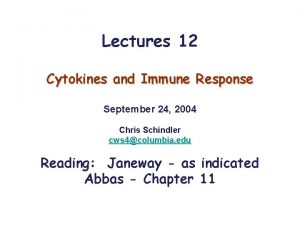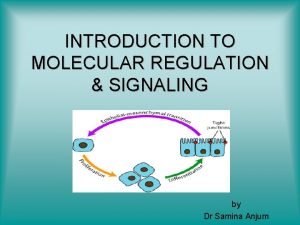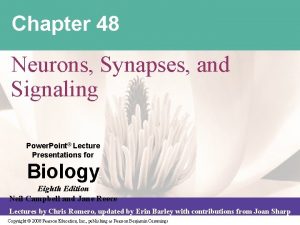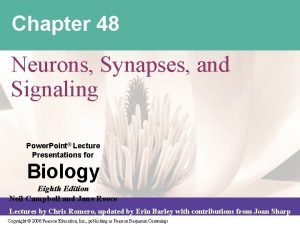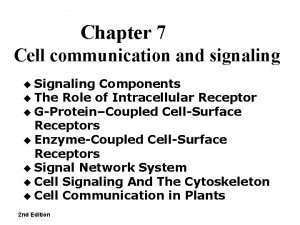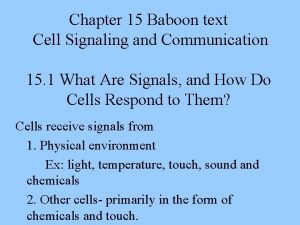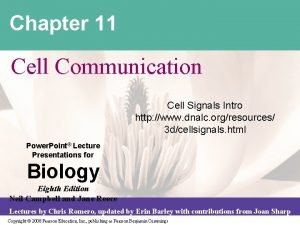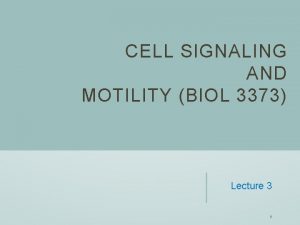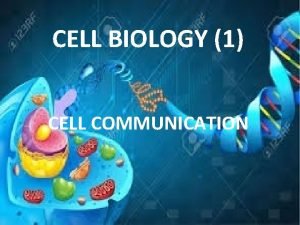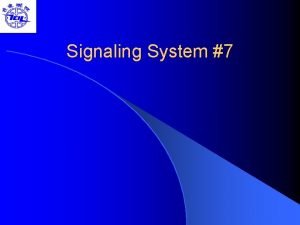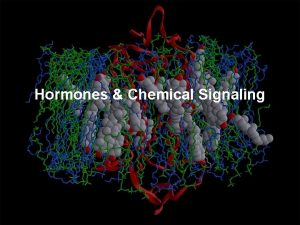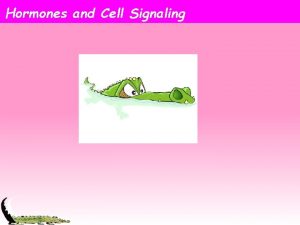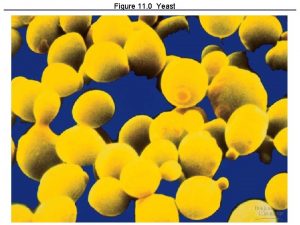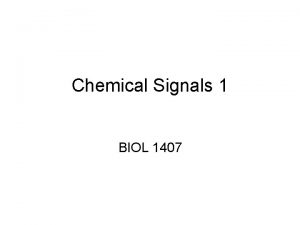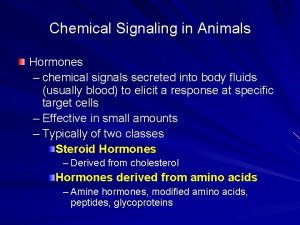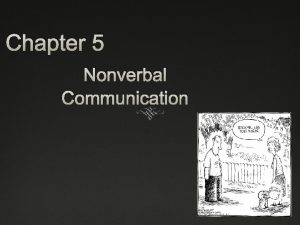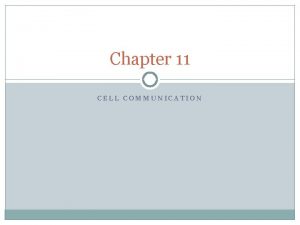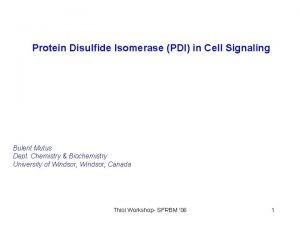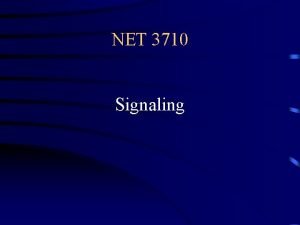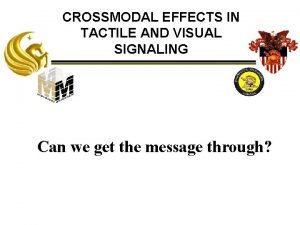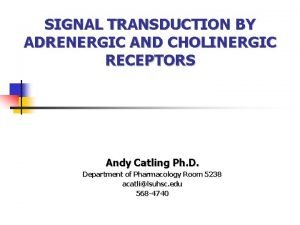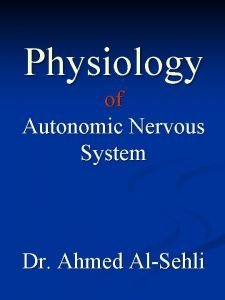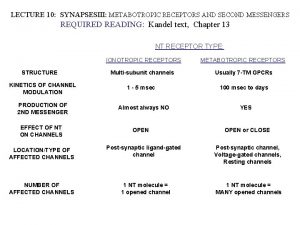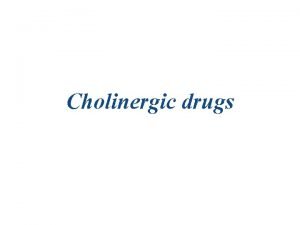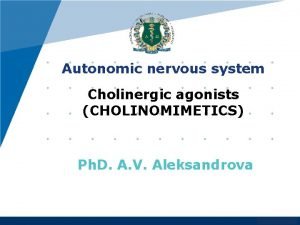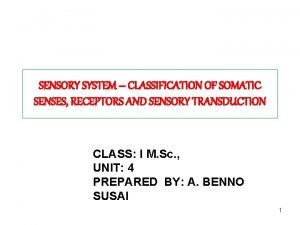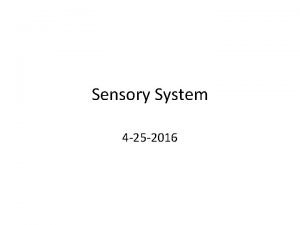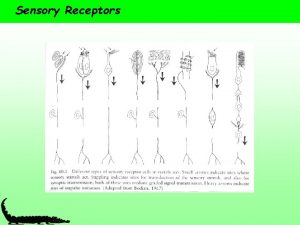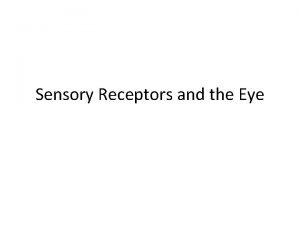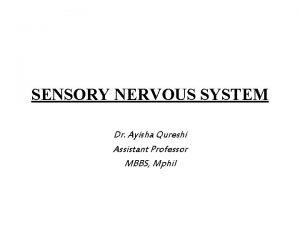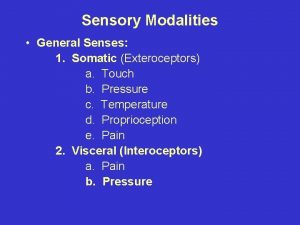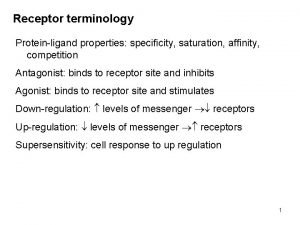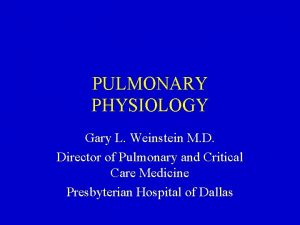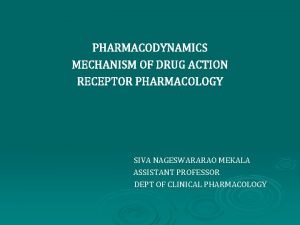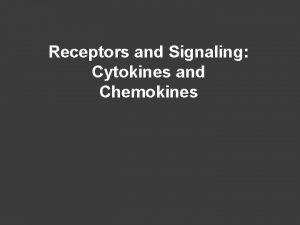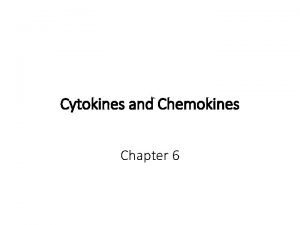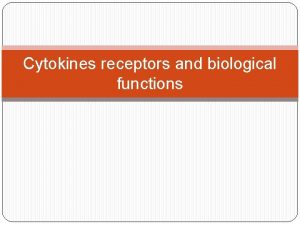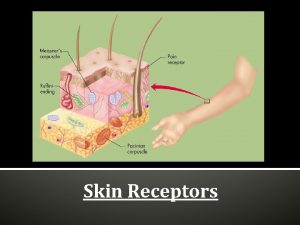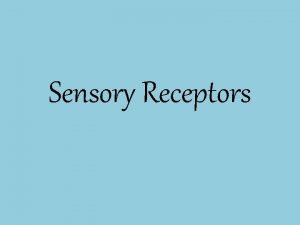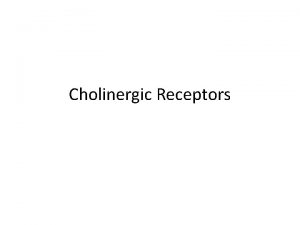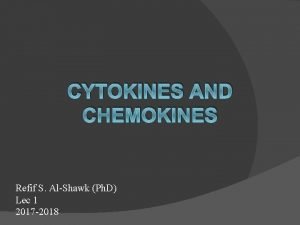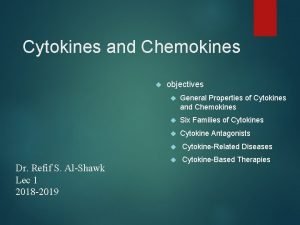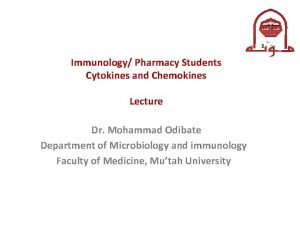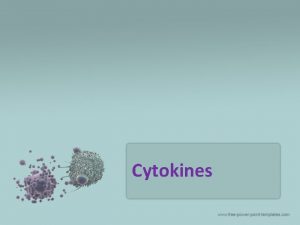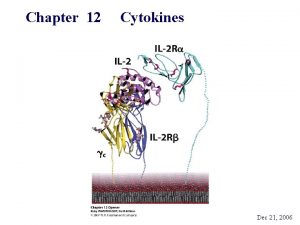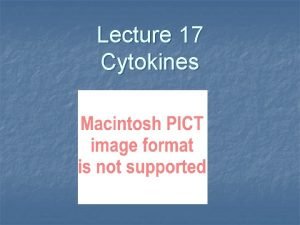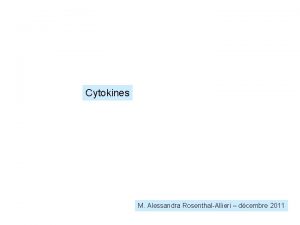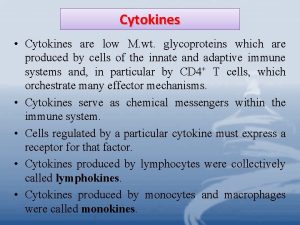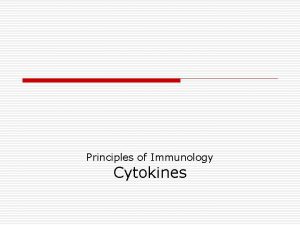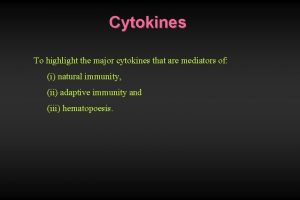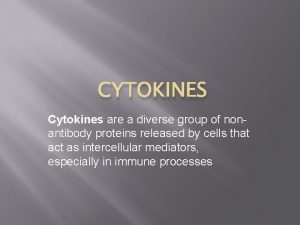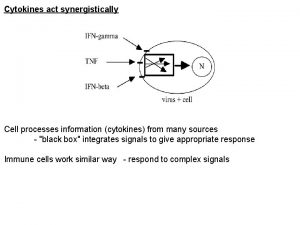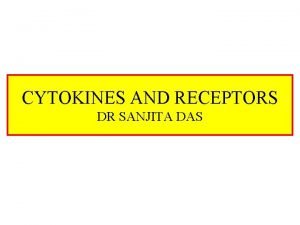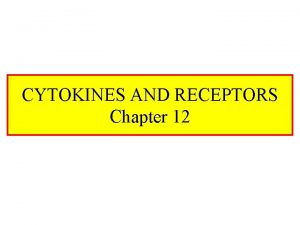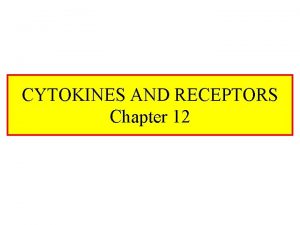Receptors and Signaling Cytokines and Chemokines Cytokines Lowmolecular













































- Slides: 45

Receptors and Signaling: Cytokines and Chemokines

Cytokines Low-molecular weight regulatory proteins or glycoproteins Secreted by WBC and various other cells Assist in regulating development of immune effector cells Referred to as Interleukins ○ IL-1 through IL-37 have been described

Chemokines subpopulation of cytokines that share the specific purpose of mobilizing immune cells from one organ, or indeed, from one part of an organ, to another. Subpopulation of cytokines Mobilize immune cells from one area to another Class of chemoattractants

General Properties of Cytokines and Chemokines 1. Cytokines Mediate the Activation, Proliferation, and Differentiation of Target Cells: Cytokines bind to specific receptors on the membranes of target cells, triggering signal transduction pathways that ultimately alter enzyme activity and gene expression. The susceptibility of a target cell to a particular cytokine is determined by the presence of specific membrane receptors and exhibit very high affinity for one another.

Cytokines bind to specific receptors Trigger signal transduction pathways that alter gene expression in target cells Exhibit pleiotropy, redundancy, synergy, antagonism, cascade induction

A cytokine that induces different biological effects depending on the nature of the target cells is said to have a pleiotropic action Two or more cytokines that mediate similar functions are said to be redundant Cytokine synergy occurs when the combined effect of two cytokines on cellular activity is greater than the additive effects of the individual cytokines The effects of one cytokine inhibit or antagonize the effects of another Cascade induction occurs when the action of one cytokine on a target cell induces that cell to produce one or more additional cytokines.


2. Cytokines Can Elicit and Support the Activation of Specific T-Cell Subpopulations; TH 1 cells secrete cytokines that ▬▬▬▬► promote the differentiation and activity of macrophages and cytotoxic Tcells, (intracellular bacteria are recognized and destroyed). How ? ? The cytokines IL-12 and interferon (IFN) γ induce TH 1 differentiation. TH 2 cells activate B cells to make antibodies, which ▬▬▬▬► neutralize and bind extracellular pathogens, ▬▬▬►making them susceptible to phagocytosis and complement-mediated lysis. How ? ? IL-4 and IL-5 support the generation of TH 2 cells. TH 17 cells promote the ▬▬▬▬► differentiation of activated macrophages and neutrophils, and support the inflammatory state; How ? ? their generation is induced by IL-17 and IL-23.


3. Cell Activation May Alter the Expression of Receptors and Adhesion Molecules What keeps cytokines from activating all T cells, for example, in a nonspecific fashion during the immune response? In order for a cell to respond to a signaling molecule, it must express receptors for that molecule, and responsiveness to a molecular signal can thus be controlled by signal receptor expression.

For example, antigen stimulation of a T cell (1) induces alterations in the T-cell surface expression of chemokine receptors. Reception of chemokine signals through these receptors therefore instructs only those cells that have previously been activated by antigen(memory) to migrate to nearby lymph nodes or to the spleen. (2) Furthermore, activation induced changes in the adhesion molecules that are expressed on the cell membrane ensures that stimulated cells migrate to, and then remain in the location best suited to their function. (3) T-cell activation by antigen also up-regulates the expression of the receptors for cytokines that provide proliferative signals, such as IL-2, and also for differentiative cytokines such as IL-4.

4. Signaling Through Multiple Receptors Can Fine Tune a Cellular Response; Cytokines can bind to more than one receptor, & receptors can bind to more than one signaling molecule.

cytokines can be classifyed on the basis of the distance between the cell secreting the signaling ligand & the cell receiving that chemical signal : Cytokines that act on cells some distance away from the secreting cell, such that they must pass through the bloodstream before reaching their target, are referred to as endocrine Those that act on cells near the secreting cell, such that the cytokine merely has to diffuse a few Ångstroms through tissue fluids or across an immunological synapse, are referred to as paracrine Sometimes, a cell needs to receive a signal through its own membrane receptors from a cytokine that it, itself, has secreted. This type of signaling is referred to as autocrine. Of note, the T-cell interleukin IL-2 acts effectively in all three modes.


Cytokines belong to 6 families ○ Interleukin 1 (IL-1) ○ Hematopoietin family (Class I) ○ Interferon family (Class II) ○ Chemokine family ○ Tumor necrosis family ○ Interleukin 17 (IL-17) Based on structural studies All have molecular mass less than 30 k. Da All have similarities and few rarely act alone

Interleukin 1 (IL-1) Family typically secreted very early in the immune response ii. by dendritic cells and monocytes or macrophages and other non-immune cells. iii. IL-1 secretion is stimulated by recognition of viral, parasitic, or bacterial antigens by innate immune receptors. iv. IL-1 family members are generally proinflammatory. i.

they induce an increase in the capillary permeability at the site of cytokine secretion, amplification of the level of leukocyte migration into the infected tissues. IL-1 has systemic (whole body) effects and signals the liver to produce acute phase These proteins further induce multiple protective effects, including the destruction of viral RNA generation of a systemic fever response (which helps to eliminate many temperature-sensitive bacterial strains). innate immune response IL-1 also activates both T and B cells at the induction of the adaptive immune response. E. X. IL-1α and IL-1β , IL-18, IL-33

The IL-1 Family of Cytokine Receptors; Two different receptors for IL-1 are known. are members of the immunoglobulin superfamily: Only the type I IL-1 R (IL-1 RI), which is expressed on many cell types, is able to transduce a cellular signal the type II IL-1 R (IL-1 RII) is limited to B cells and is inactive. Note that both the IL-1 RI and the IL-1 RII receptor chains exist in both soluble and membrane-bound forms.

Secreting more or fewer of these inactive receptors, at different times during an immune response, the organism has the opportunity to fine-tune the cytokine signal ? ? Why & How? ? By allowing the inactive and soluble receptors to compete with the signaltransducing receptor for available cytokine. This strategy is important for controlling the strength of signals that give rise to important outcomes.

Hematopoietin (Class I) Family ○ Called Class I because earliest to be structurally characterized (not first to be discovered) ○ Not all involved in hematopoietic functions

Their cellular origins and target cells are as diverse as their ultimate functions, which range from; signaling the onset of T- and B-cell proliferation (e. g. , IL-2), to signaling the onset of B-cell differentiation to plasma cells and antibody secretion (e. g. , IL-6), to signaling the differentiation of a T helper cell along one particular differentiation pathway versus another (e. g. , IL-4 vs. IL-12) and finally, to initiating the differentiation of particular leukocyte lineages (e. g. , GM-CSF, GCSF).

The Hematopoietin or Class I Receptor Family The γ-Chain Bearing, or IL-2 Receptor, Subfamily: Expression of a common γ chain defines the IL-2 receptor subfamily, which includes receptors for IL -2, IL-4, IL-7, IL-9, IL-15, and IL-21. The IL-2 and the IL-15 receptors are heterotrimers, consisting of α chain and (β and γ) responsible for both signal transduction and cytokine recognition. The IL-2 receptor γ chain also functions as the signaltransducing subunit for the other receptors in this subfamily, which are all dimers.

The IL-2 receptor occurs in three forms, each exhibiting a different affinity for IL-2: the low-affinity monomeric IL-2 Rα (CD 25) (which can bind to IL-2, but is incapable of transducing a signal from it), the intermediate-affinity dimeric IL-2 Rβγ (which is capable of signal transduction), and the high-affinity trimeric IL-2 Rαβγ (which is responsible for most physiologically relevant IL-2 signaling).

Theintermediate affinity IL-2 receptors are expressed on resting T cells and on NK cells, whereas activated T and B cells express both the low-affinity and the high-affinity receptor forms.


What may the function of the low-affinity receptor be? It may serve to concentrate IL-2 onto the recipient cell surface for passage to the high-affinity receptor it may reduce the local concentration of available IL-2, ensuring that only cells bearing the highaffinity receptor are capable of being activated. Whatever the answer to this question may be, the restriction of the high-affinity IL-2 receptor expression to activated T cells ensures that only antigen-activated CD 4 and CD 8 T cells will proliferate in response to physiologic levels of IL-2.

The β Chain Bearing, or GM-CSF, Receptor Subfamily Members of the GM-CSF receptor subfamily, which includes the receptors for IL-3, IL-5, and GM-CSF, share the β signaling subunit. binds with low affinity α subunit of a dimeric receptor. All three low-affinity subunits associate noncovalently with the common signaltransducing subunit. The resulting αβ dimeric receptor has a higher affinity for the cytokine than the specific α chain alone, and is also capable of transducing a signal across the membrane upon cytokine binding.


Interferon (Class II) ○ First cytokines to be discovered ○ Type I - Secreted by not only macrophages and dendritic cells but also by virus infected cells: (1) Interferons α, and (2) interferon-β, ○ Type II – produced by activate T and NK cells , known as interferon-γ & cytokines include IL-10 o Third class, interferon-λ. This type up-regulate the expression of genes controlling viral replication and host cell proliferation.


All three interferons (1) increase the expression of MHC complex proteins on the surface of cells, thus enhancing their antigen-presentation capabilities. (2) Interferon-γ is used medically to bias the adaptive immune system toward a cytotoxic response in diseases such as leprosy and toxoplasmosis, in which antibody responses are less effective than those that destroy infected cells.

ØInterferon Receptors are heterodimers that share the same with members of the Hematopoietin receptor family ØThe JAK-STAT Signaling Pathway


Tumor Necrosis Family (TNF) ○ Cytokines regulates the development, effector function, and homeostasis of cells participating in the skeletal, neuronal, and immune systems, among others. Cytokines of the TNF Family ○ There are two members having the same name of the TNF family: TNF-α and TNF-β. Both of these are secreted as soluble proteins.

TNF- is a proinflammatory cytokine, produced primarily by activated macrophages, but also by other cell types including lymphocytes, fibroblasts, and keratinocytes (skin cells), in response to infection, inflammation, and environmental stressors. TNF elicits biological effects by binding to its receptors.

TNF Receptors ﺍﻋﺘﺮﺍﺽ TNF-R 1: ○ TNF-R 1, can transduce both activating and death promoting signals, depending on the local cellular and molecular environment in which the signal is received. ○ few family members are cleaved from the membrane to form soluble receptor variants ○ These soluble forms of TNF family receptors are known as “decoy receptors, ” as they are capable of intercepting ﺍﻋﺘﺮﺍﺽ the signal from the ligand before it can reach a cell, effectively blocking the signal.

Fas Receptor: ○ proapoptotic (death inducing) pathway that is initiated when the membrane-bound TNF family member Fas. L on one cell binds to a Fas receptor on a second cell, leading to death in the cell bearing the Fas receptor {programmed cell death, is a mechanism of cell death in which the cell dies from within and is fragmented into membrane-bound vesicles that can be rapidly phagocytosed by neighboring macrophages. } The activation of this cascade is : condensation of nuclear material the degradation of nuclear DNA breakdown of the cell into “easily digestible” membrane-bound fragments.

IL-17 Family ○ Most recently described cytokines ○ Proinflammatory cytokine cluster interleukins 17 A, 17 B, 17 C, 17 D, and 17 F Ø T cells secreting IL-17 A represent a new lineage, the TH 17 cell subset, IL-17 family share the property of operating at the interface of innate and adaptive immunity, serving to coordinate the release of proinflammatory and neutrophilmobilizing cytokines. Ø IL-17 E promot the differentiation of the antiinflammatory TH 2 subclass, suppressing further TH 17 cell responses, Ø

Chemokines Direct the Migration of Leukocytes Through the Body; Are structurally related family of small cytokines that bind to cell-surface receptors and induce the movement of leukocytes up a concentration gradient and toward the chemokine source. located on the surfaces of endothelial cells, enables them to bind to the inner surfaces of blood vessels and directing leukocyte movement.

The grouping of chemokines into the subclasses has functional, as well as structural, significance. The seven human CXC chemokines share the same receptor (CXCR 2), attract neutrophils, are angiogenic (it promotes the formation of new blood vessels. ) Members of the two, structurally distinct CC groups are chemoattractants that attract monocytes and macrophages (although not neutrophils) to the site of infection.

Cytokine Antagonists Number of proteins can inhibit cytokine activity Can bind to receptor but fail to activate the cell, thus blocking the active cytokine from binding Can bind to cytokine, inhibiting its ability to bind to the cognate receptor A naturally occurring cytokine antagonists that modulate and refine the power of particular cytokine responses: Regulatory T cells, which express high levels of CD 25 on their membrane surfaces, have been shown to release s. IL-2 R upon activation. Since these T cells serve the function of downregulating ongoing immune responses, (soluble IL-2 receptors serve the physiological function of soaking up excess IL-2 ) thus reducing the amount of the cytokine that is available. Some Viruses Have Developed Strategies to Exploit Cytokine Activity: Epstein-Barr virus (EBV), for example, produces an IL-10–like molecule (viral IL-10 or v. IL-10) that binds to the IL-10 receptor. Just like hostderived IL-10, this viral homologue suppresses TH 1 -type cell-mediated responses that would otherwise be effective in fighting a viral infection.

Cytokine Related Diseases Sever combined immunodeficiency (SCID) Genetic defects in cytokines, their receptors Defective receptor for IFN-γ Susceptible to mycobacterial infections

Cytokine Related Diseases Bacterial Septic Shock Certain bacteria: Staphyloccocus aureus, E. coli, Klebsiella pneumoniae …. . Symptoms: drop in blood pressure, fever, diarrhea, blood clotting Endotoxins (cell wall) bind TLRs on dendritic cells and macrophages leading them to produce ○ Over-produce IL-1β and TNF-α ○ Cytokine imbalance causes abnormal temp, abnormal respiration, capillary leakage, tissue injury, organ failure ○ Neutralization by monoclonal antibodies may help

Cytokine Related Diseases Bacterial Toxic Shock Microorganisms produce toxins that act as Superantigens ○ Bind simultaneously to Class II MHC and T cell receptor, activating T cell despite antigenic specificity , , induce extremely high levels of TNF-α and IL-1β Symptoms similar to sepsis

Cytokine-Based Therapies; Soluble TNF-α receptor and monoclonal antibodies against TNF-α have been used to treat rheumatoid arthritis and ankylosing spondylitis in more than a million patients. Which reduce proinflamatory cytokine cascades; help to alleviate pain, stiffness, and joint swelling; and promote healing and tissue repair. The recombinant form of IL-1 Ra has been shown to be relatively effective in the treatment of rheumatoid arthritis. Monoclonal antibodies directed against the α chain of the IL-2 R are also in clinical use for the prevention of transplantation rejection reactions
 Cytokines examples
Cytokines examples Discourse analysis and vocabulary
Discourse analysis and vocabulary Discourse organizing words
Discourse organizing words Autocrine and juxtacrine signaling
Autocrine and juxtacrine signaling Autocrine and juxtacrine signaling
Autocrine and juxtacrine signaling Chapter 48 neurons synapses and signaling
Chapter 48 neurons synapses and signaling Chapter 48 neurons synapses and signaling
Chapter 48 neurons synapses and signaling Signal phrases definition
Signal phrases definition Vehicle ground guide hand signals
Vehicle ground guide hand signals Cell communication types
Cell communication types 3 types of cell signaling
3 types of cell signaling Dot
Dot 3 stages of cell communication
3 stages of cell communication Ligand signaling molecule
Ligand signaling molecule Signaling system 7
Signaling system 7 Chemical signaling
Chemical signaling Exocrine cell signaling
Exocrine cell signaling Phosphorylation cascade
Phosphorylation cascade Chemical signaling
Chemical signaling Chemical signaling
Chemical signaling Fragmented industry
Fragmented industry Nonverbal communication substituting
Nonverbal communication substituting Cell signaling
Cell signaling Cell signaling overview
Cell signaling overview Pdi cell signaling
Pdi cell signaling Loop start signaling
Loop start signaling Use visual signaling techniques
Use visual signaling techniques Cholinergic vs adrenergic
Cholinergic vs adrenergic Difference between alpha and beta receptors
Difference between alpha and beta receptors Difference between ionotropic and metabotropic receptors
Difference between ionotropic and metabotropic receptors Blocking muscarinic receptors would
Blocking muscarinic receptors would Muscarinic vs nicotinic effects
Muscarinic vs nicotinic effects Tuberous receptors
Tuberous receptors Olfactory receptors
Olfactory receptors Types of sensory receptors
Types of sensory receptors Sensory coding
Sensory coding Baroreceptors chemoreceptors mechanoreceptors
Baroreceptors chemoreceptors mechanoreceptors Classification of sensory receptors
Classification of sensory receptors Eye sensory receptors
Eye sensory receptors Receptive fields of sensory neurons
Receptive fields of sensory neurons Exteroceptors examples
Exteroceptors examples 3 types of lung receptors
3 types of lung receptors J receptors
J receptors Derine
Derine J receptors
J receptors Receptors in pharmacology
Receptors in pharmacology
